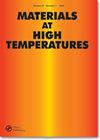Creep of IN738LC manufactured with laser powder bed fusion: effect of build orientation and twinning
IF 0.9
4区 材料科学
Q4 MATERIALS SCIENCE, MULTIDISCIPLINARY
引用次数: 0
Abstract
ABSTRACTThe microstructural anisotropy caused by the highly oriented solidification of the metal Laser Powder Bed Fusion (PBF-LB/M) process affects mechanical short- and long-term properties. Component build orientation influences grain morphology and orientation, and thus, mechanical properties. While the creep behaviour of samples manufactured parallel and perpendicular to the build direction are studied intensively, the 45° build orientation remains uncharacterised. In this study, IN738LC creep samples are manufactured via PBF-LB/M in three build orientations (0°, 45° and 90°). While the results of 90° and 0° are as expected, where 90° achieves the longest time to rupture and largest rupture strain, the 45° specimen shows the least fracture time. Differences in microstructure and twinning behaviour are identified as one of the root causes for this unexpected behaviour. This study discusses the correlation between microstructure, twinning and build orientation and their effect on creep behaviour, with special focus on the 45° build orientation.KEYWORDS: Laser powder bed fusionIN738LCbuild orientationcreepmicrostructuretwinning Disclosure statementNo potential conflict of interest was reported by the author(s).PatentsThere are no patents resulting from the work reported in this manuscript.Notes1. Hausner ratio, h = .Tapped Powder DensityBulk Powder Density2. Volume energy density,EV = Laser PowerScan Speed×Hatch Distance×Layer ThicknessAdditional informationFundingThe research project (FVV project no.1401) was performed by the Institute of Materials Technology of the Technical University Darmstadt under the guidance of Prof. Dr.-Ing. Matthias Oechsner and by the Materials Testing Institute at the University of Stuttgart under the guidance of Prof. Dr.-Ing. Stefan Weihe. Based on a decision taken by the German Bundestag, it was supported by the Federal Ministry for Economic Affairs and Climate Action (BMWK) and the AIF (German Federation of Industrial Research Associations eV) within the framework of the industrial collective research (IGF) programme (IGF No. 21220 N/1) The authors gratefully acknowledge the support received from the funding organisations, from the FVV eV and from all those involved in the project.激光粉末床熔合制备IN738LC的蠕变:构向和孪晶的影响
摘要金属激光粉末床熔合(PBF-LB/M)过程中高度定向凝固引起的显微组织各向异性影响了材料的短期和长期力学性能。构件的构造取向影响晶粒的形貌和取向,从而影响力学性能。虽然与构建方向平行和垂直的样品的蠕变行为得到了深入研究,但45°构建方向仍然没有表征。在本研究中,通过PBF-LB/M在三种构建方向(0°,45°和90°)下制造IN738LC蠕变样品。90°和0°试样的断裂时间最长,断裂应变最大,而45°试样的断裂时间最短。微观结构和孪晶行为的差异被认为是导致这种意外行为的根本原因之一。本研究讨论了微观结构、孪晶和构建取向之间的关系及其对蠕变行为的影响,特别关注了45°构建取向。关键词:激光粉末床fusionIN738LCbuild取向蠕形显微结构孪生披露声明作者未报告潜在利益冲突。专利本文中报告的工作没有产生专利。豪斯纳比,h = .散粉密度。本研究项目(FVV项目no.1401)由德国达姆施塔特工业大学材料技术研究所在dr . ing教授的指导下完成。Matthias Oechsner和斯图加特大学材料测试研究所的Prof. ing博士的指导下。Stefan境内渭河。根据德国联邦议院的决定,该研究得到了联邦经济事务和气候行动部(BMWK)和德国工业研究协会联合会(AIF)在工业集体研究(IGF)计划(IGF No. 21220 N/1)框架内的支持。作者感谢资助组织、FVV eV和所有参与该项目的人员的支持。
本文章由计算机程序翻译,如有差异,请以英文原文为准。
求助全文
约1分钟内获得全文
求助全文
来源期刊

Materials at High Temperatures
工程技术-材料科学:综合
CiteScore
1.90
自引率
15.40%
发文量
58
审稿时长
>12 weeks
期刊介绍:
Materials at High Temperatures welcomes contributions relating to high temperature applications in the energy generation, aerospace, chemical and process industries. The effects of high temperatures and extreme environments on the corrosion and oxidation, fatigue, creep, strength and wear of metallic alloys, ceramics, intermetallics, and refractory and composite materials relative to these industries are covered.
Papers on the modelling of behaviour and life prediction are also welcome, provided these are validated by experimental data and explicitly linked to actual or potential applications. Contributions addressing the needs of designers and engineers (e.g. standards and codes of practice) relative to the areas of interest of this journal also fall within the scope. The term ''high temperatures'' refers to the subsequent temperatures of application and not, for example, to those of processing itself.
Materials at High Temperatures publishes regular thematic issues on topics of current interest. Proposals for issues are welcomed; please contact one of the Editors with details.
 求助内容:
求助内容: 应助结果提醒方式:
应助结果提醒方式:


